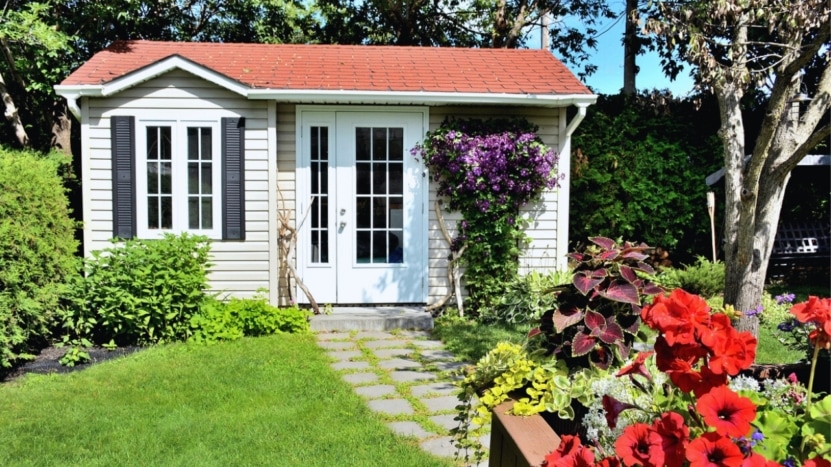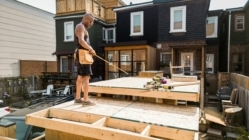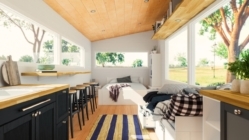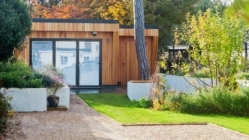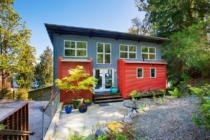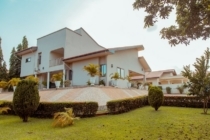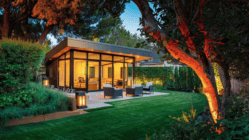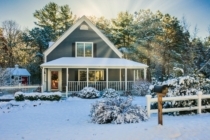Getting a clear understanding of ADU costs and finding the right ADU financing options is a crucial step for any homeowner looking to build an Accessory Dwelling Unit (ADU) on their property. This article will shed light on the financial implications and help you navigate the available financing options.
Understanding the Cost of Building an ADU
When researching and planning out your ADU construction, it’s crucial to have a clear picture of the costs involved. Typically, building an ADU can range from $50,000 to $250,000, influenced by factors like size, location, design, and material choices.
However, this range is just a starting point. You’ll also need to consider permit fees, utility connections, and even landscaping, which can add to your total investment. Furthermore, an increase in your property value might lead to higher property taxes, an important budget consideration.
Navigating through the cost of ADU construction requires careful planning. Beyond the immediate expenses, it’s wise to consider potential hidden costs and future financial obligations. This holistic approach ensures you’re fully prepared for the financial journey ahead, minimizing surprises and managing your budget effectively.
What Influences the Cost of ADU Construction?
Building an ADU represents a significant investment, with a broad range of cost variables coming into play. The typical starting price is around $50,000 but can rise upwards of $250,000. Let’s explore the factors that can contribute to lower or higher ADU costs:
Core Cost Drivers
- Size: Square footage heavily influences the ADU expense. It drives needs for building materials, from basic structural supplies to interior finishes. A larger footprint usually equates to a higher price tag.
- Location: Material and labor costs fluctuate depending on where you live. High-demand areas might command higher prices for both raw supplies and skilled contractors. Additionally, areas with tighter building codes could require specialized solutions for permitting, thus impacting the costs.
- Features & Finishes: The level of detail influences the expense. Choosing custom elements (elaborate kitchen with high-end appliances, custom windows) and luxurious finishes naturally leads to a higher price. Opting for simpler designs and standard options helps manage costs.
- Local Laws & Regulations: Regulatory specifics greatly vary between municipalities. Permit fees, zoning rules, and even utility connection charges are subject to your locality. Some might even have design restrictions. Researching local requirements ensures realistic budgeting.
These are the big contributors, but don’t overlook ‘smaller’ expenditures. Things like utility hookups, landscaping, and even higher property taxes can impact the bottom line. A budget that carefully considers all details helps avoid unwelcome surprises.
How to Finance Building an ADU
Deciding on the ideal way to finance your ADU can feel overwhelming. Your personal financial situation will dictate the best path forward. Let’s dive into the most common financing methods and compare their advantages and drawbacks:
Home Equity Line of Credit (HELOC)
A HELOC is a large credit line secured by the equity in your home. Equity is the portion of your home’s value you own outright. Ato funds is flexible – you can borrow as much or as little as needed, when needed, and you can pay down your balance and re-borrow funds over and over. HELOCs have adjustable rates and can be obtained with very few or no costs at all.
Pros:
- Low cost and low interest rates compared to other 2nd mortgage options.
- Payments can be “interest only” against only the amount withdrawn/borrowed.
- No required contractor bids or information related to your ADU project.
Cons:
- Your home acts as collateral, meaning you could lose it if you default on payments.
- Variable interest rates mean they can increase at any time.
- The available credit line might not be large enough to cover the full ADU cost.
Cash-Out Mortgage
A cash-out mortgage loan refinances your existing mortgage, replacing it with a larger loan. The difference between the new mortgage and the previous one is the “cash out”, and it can be used to fund your ADU construction.
Pros:
- Fixed interest rates offer security and consistent payments.
- Lower interest rates than an unsecured loan or a 2nd mortgage might offer.
- No contractor bids or details about your ADU project are necessary for funding.
Cons:
- Interest begins accruing immediately on the entire loan balance (in contrast to a HELOC that allows you to borrow when you need the funds).
- Refinancing could result in a higher interest rate than your current mortgage has.
- Refinance could extend your mortgage repayment term, adding years to your overall debt.
Fannie Mae HomeStyle Renovation Loan
Designed for major renovation projects, the Fannie Mae HomeStyle Renovation Loan bundles the cost of both the ADU and your new home into a single loan. These loans can also be used in conjunction with a refinance. This is a construction loan of sorts where borrowers get approved for a loan that is large enough to cover all of the costs associated with ADU construction. The appraisal will be done on a “Subject To” basis, meaning the appraiser will appraise the property as if the ADU has already been constructed. Because of this, the appraiser will need to see the plans and specifications for the ADU when she appraises the property. Underwriters will also need to see the plans, specifications and bids from a licensed and approved contractor before the loan is approved. A huge advantage of these loans is that they lend up to 97% loan-to-value.
Pros:
- Fixed interest rate provides security and consistent payments.
- The loans usually provide enough funds to cover the entire cost of the ADU construction project.
- Can be used for either purchasing a home or refinancing your current one.
- Financing is available up to 97% loan-to-value based on the future value of the property – making this option exceptionally advantageous for borrowers with limited cash.
Cons:
- Complexity of financing requires more time to close.
- Detailed plans and contractor bids are required before the loan is approved or funds distributed.
- Funds are distributed via a “draw system” and not all at once, limited contractors to a specific schedule.
Freddie Mac ChoiceRenovation Loan
Very similar to Fannie Mae’s HomeStyle loan, the Freddie Mac ChoiceRenovation Loan integrates ADU funding into your home purchase or refinance. Like Fannie’s offering, this too is a construction loan of sorts where borrowers get approved for a loan that is large enough to cover all of the costs associated with ADU construction. The appraisal will be done on a “Subject To” basis, meaning the appraiser will appraise the property as if the ADU has already been constructed. Because of this, the appraiser will need to see the plans and specifications for the ADU when she appraises the property. Underwriters will also need to see the plans, specifications and bids from a licensed and approved contractor before the loan is approved. A huge advantage of these loans is that they lend up to 97% loan-to-value.
Pros:
- Can use the rents from ADU to help qualify – something Fannie Mae does not allow.
- Fixed interest rate provides security and consistent payments.
- The loans usually provide enough funds to cover the entire cost of the ADU construction project.
- Can be used for either purchasing a home or refinancing your current one.
- Financing is available up to 97% loan-to-value based on the future value of the property – making this option exceptionally advantageous for borrowers with limited cash.
Cons:
- Complexity of financing requires more time to close.
- Detailed plans and contractor bids are required before the loan is approved or funds distributed.
- Funds are distributed via a “draw system” and not all at once, limited contractors to a specific schedule.
Need Help Understanding Your ADU Financing Options?
Selecting the financing that best suits your ADU project is a pivotal decision. The top methods outlined have both advantages and disadvantages to weigh carefully. Your individual financial picture, existing home equity, and comfort with risks will all factor into the optimal choice. Don’t hesitate to consult with a mortgage expert at JVM Lending, who can offer guidance and present additional options that might better fit your circumstances.
ADU Financing FAQs
Can I use the rental income from an ADU to qualify for a loan?
Yes, recent guidelines from Freddie Mac allow borrowers to use potential rental income from an ADU to help qualify for a loan, similar to how rental income from a duplex might be considered. This can increase your borrowing power by factoring in the additional income the ADU could generate.
What is the average cost to build an ADU?
The cost of building an Accessory Dwelling Unit (ADU) can vary widely, typically ranging from $50,000 to $250,000. This range is influenced by factors such as the size of the unit, its location, the complexity of the design, and the materials chosen for construction. Keep in mind, these figures are estimates and the actual cost can be higher or lower depending on specific project details.
Can I build an ADU if I don’t have equity in my home?
Building an ADU without home equity is possible with both Fannie Mae’s Homestyle Renovation Loan and Freddie Mac’s ChoiceRenovation Loan. This is because you can appraise your property “subject to completion,” as if the ADU is already constructed. We can lend up to a 95% to 97% loan-to-value ratio based on the future value of your property.
How do I choose the best financing option for my ADU project?
Choosing the best ADU financing option depends on your personal financial situation, the equity you have in your home, and your long-term financial goals. It’s important to consider the interest rates, loan terms, and any potential impact on your future financial flexibility. Consulting with a mortgage expert at JVM Lending can help you make an informed decision that aligns with your needs and objectives.
Are there any hidden costs I should be aware of when building an ADU?
Yes, aside from the obvious construction costs, there are several hidden or additional expenses to consider, including:
- Utility Connection Fees: Connecting your ADU to utilities can be costly. Depending on the planned location of your ADU, running new water, sewer, and electrical lines may be a project on its own. Existing infrastructure plays a significant role in determining these costs.
- Landscaping: Enhancing the outdoor space around your ADU can add to the overall cost.
- Property Taxes: The addition of an ADU can increase your property’s value and, consequently, your property taxes.
- Permitting Fees: Depending on your location, the cost and requirements for obtaining the necessary permits can vary.
- Site Preparation: Is the site level, or is grading or excavation required? Clearing trees, or relocating major utilities, can add considerable expenses.
Next Step: Get Personalized ADU Financing Options
At JVM Lending, we offer several specialized ADU financing options and are ready to guide you through the process. With the right financial approach, you can transform your property, expanding its potential and unlocking new pathways to accommodate your changing needs.
If you’re ready to take the next step and explore the potential of adding an ADU to your property, let JVM Lending help you pave the way with personalized financing solutions.
Reach out to us for a free consultation today, or contact us directly at (855) 855-4491 or email [email protected].

